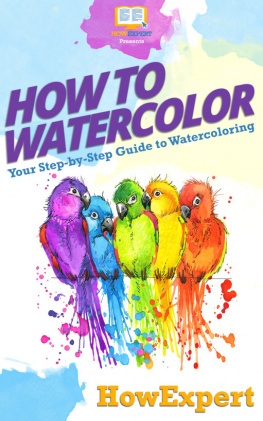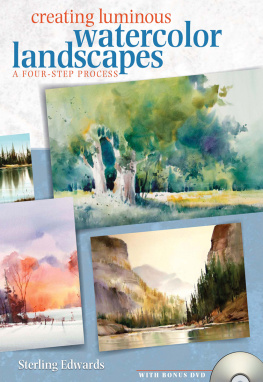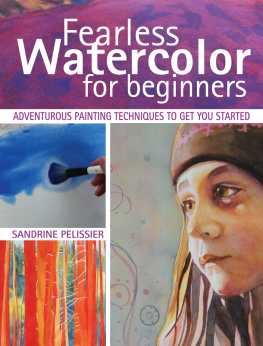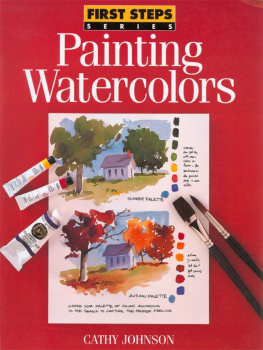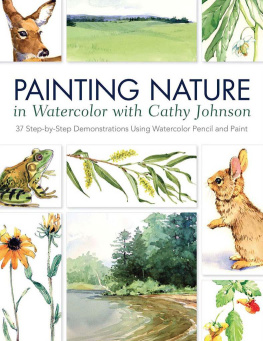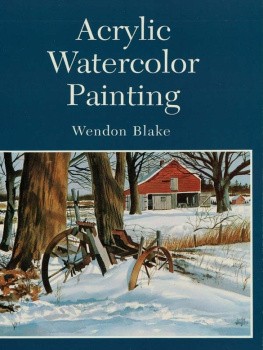Watercolor Unleashed
New directions for traditional painting techniques
JULIE GILBERT POLLARD

Introduction

ITTLIE BITTIE FISHIES
Watercolor on board
19 19 (48cm 48cm)

EARLY FALL, TRINITY RIVER
Watercolor on canvas
12 12 (30cm 30cm)
Watercolorespecially an expanded watermedia version of watercoloris an exciting and expressive medium. You can do almost anything with it, particularly when using the many water-based products, papers and canvases that are available to us.
Watercolor has been maligned as an extremely unforgiving medium. While this is true to some extent, even purely transparent watercolor is more easily manipulated than you might imagine. As you go through the step-by-step demos, you will see where paint has been gently lifted or not so gently scrubbed, then repainted in such a way as to revive freshness. Then, in a worst case scenario, painted over with gouache, casein or acrylic.
Regarding opaque media, lest you think the addition of an opaque medium such as gouache is merely a last resort fix, it must be said that opaque mediums can add beautiful qualities and dimensions to a painting that you might not be able to achieve otherwise. It must also be acknowledged that opaque media are highly respected in their own right, so why not incorporate any and all media to improve and complete a painting?
Still, watercolor can be a mysterious and challenging mediumand even with experience, truth be told, the challenge remains. As artists, we simply keep raising the bar and expecting more of ourselvesas happens with every worthwhile endeavor. And if we werent the kind of folk who need to be challenged, we wouldnt be painting!
Most of my work in watercolor is transparent. But I am not a puristmy philosophy is of the whatever works school. Not bound by tradition but truly watercolor unleashed!
So, come with me and lets see if we can demystify the processand delight in the practice of this beautiful and versatile medium.
Basic Watercolor Materials
Whatever you do, do not buy all the colors or other supplies you see here just because theyre on my list. I often use no more than six colors in any given painting and can get by with three. I have labeled the colors as warm, warmer, cool, cooler and very cool. I use no earth tones and few secondary colors.
YELLOW PIGMENTS
Winsor Yellow (Winsor & Newton)
Nickel Azo Yellow (Winsor & Newton)
New Gamboge (Winsor & Newton)warm
Indian Yellow (M. Graham or Winsor & Newton)warmer
RED PIGMENTS
Scarlet Lake (Holbein) or Quinacridone Red (M. Graham)warm
Permanent Alizarin Crimson (Winsor & Newton)cool
Permanent Rose (Winsor & Newton) or Quinacridone Rose (M. Graham)cool
Quinacridone Magenta (Winsor & Newton)cooler
BLUE PIGMENTS
Ultramarine Deep (Holbein)warmer
Cobalt Blue (Winsor & Newton or M. Graham [for plein air palette])warm
Indanthrene Blue (Winsor & Newton) or Anthraquinone Blue (M. Graham)warm
Antwerp Blue (Winsor & Newton)cool
Cerulean Blue (Winsor & Newton)cool
Manganese Blue Nova (Holbein or M. Graham Manganese Blue Hue [for plein air palette])cooler
Transparent Turquoise (Daler-Rowney)cooler
Turquoise Blue (Holbein)cooler
Ultramarine Turquoise (Daniel Smith)very cool
OPAQUE COLORS
Titanium White Casein (Shiva) or Titanium White Gouache (no particular brand)
Jaune Brillant # 1 (Holbein)
Jaune Brillant # 2 (Holbein)
Primary Yellow (Winsor & Newton Designers Gouache)
BRUSHES
Nos. 8 and 14 nylon, synthetic or natural blend rounds (Connoisseur Kolinsky sable or Winsor & Newton Sceptre Gold 101)
-inch (12mm), -inch (19mm) and 1-inch (25mm) nylon or synthetic blend Aquarelle (no particular brand)
2-inch (5mm) hake (no particular brand) or wash brush
No. 4 scrubber (Creative Mark)
SUPPORT
100% rag, 140-lb. (300gsm) or 300-lb. (640gsm) cold-pressed watercolor paper (Lanaquarelle, Winsor & Newton, Canson Montval or Arches)
Multimedia canvas (Yes!) or watercolor canvas (Fredrix). Use sheets stapled to Gatorboard. Canvas prestretched onto stretcher bars or premounted onto boards are also available.
A Word About Watercolor on Canvas
Painting on canvas can take some getting used to, but a huge benefit is that when the painting is properly sealed, neither mat nor glass is required for framing a canvas piece. More importantly, watercolor canvas forces you into a looser handling since the watercolor is a little more difficult to control. The paint sits on the surface. The appearance of the canvas texture is also very appealing. The disadvantage for many is that canvas is not usually accepted in watercolor organization exhibits. If you intend to submit to one of these exhibits, make sure you read the requirements carefully.
Additional Watercolor Materials
DRAWING SUPPLIES
2B drawing pencils
Charcoal pencil, soft or medium
Colored pencils (Prismacolor) in various grays or Mulberry
Drawing board (a piece of Gatorboard or Plexiglas)
Eraserclick eraser, gum eraser or kneadable eraser
Pencil sharpener
Sketch book
Tracing paper
MISCELLANEOUS SUPPLIES
Bulldog clips
Glycerin (to keep natural-hair brushes moisturized)
Hair dryer
Large water container
Masking fluid (Winsor & Newton Colourless Art Masking Fluid or Incredible White Mask Liquid Frisket)
Natural sponge
Spray bottle (I use eyeglasses cleaner spray bottles for their fine mist spray.)
Watercolor ground (Daniel Smith Watercolor Ground) that can be applied to paper, canvas or board
Watercolor palette with lid (Mijello Fusion watercolor palette or Heritage folding palette)
White facial tissues
PREPPING YOUR SURFACE
Multimedia canvas and watercolor canvas come four ways: by the roll, sheets in a tablet, prestretched on stretcher bars, or mounted onto boards. I buy mine by the roll but will sometimes pick up a couple of prestretched canvases.
When using a loose watercolor or multimedia canvas sheet, you must first staple it down on Gatorboard. Staple the longest edge first, stretching the canvas taut, with the staples about an inch or so apart. Then use a clean, wet sponge to wipe down the surface, swiping the sponge towards the unstapled edges. This stretches the canvas out a bit so that when it dries, it will be smooth and taut. This also makes the surface more accepting of watercolor. Staple the remaining edges while the canvas is still wet. If you plan to paint on it wet-into-wet without first drawing, you can do it now. If you wish to draw your composition before painting, allow the canvas to dry completely first.


